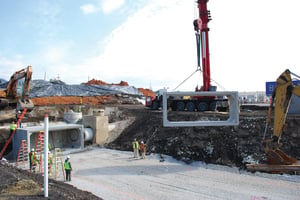SPECIFICATIONS
Specifications for Concrete Pipe & Box Culverts
In most cases the manufacturing of concrete pipe and box culverts and their installation and testing requirements are governed by ASTM Standards or relatively equivalent AASHTO Standards. To make specifying concrete pipe easier, the American Concrete Pipe Association has compiled all the relevant ASTM standards into one manual, “ACPA’s Annual Book of Selected ASTM Standards”, which can be found on our Resources web page.
ASTM and AASHTO Standards for Reinforced Concrete Pipe
Indirect Design
- ASTM C76-11 Standard Specification for Reinforced Concrete Culvert, Storm Drain, and Sewer Pipe.
- AASHTO M 170-09 Standard Specification for Reinforced Concrete Culvert, Storm Drain, and Sewer Pipe.
Direct Design
- ASTM C1417-08 Standard Specification for Manufacture of Reinforced Concrete Sewer, Storm Drain, and Culvert Pipe for Direct Design.
- AASHTO Section 12 of the LRFD Code provides provisions to perform a direct design of concrete pipe.
ASTM and AASHTO Standards for Precast Box Culverts
Standard Design Code
- ASTM C 1433 Precast Reinforced Concrete Monolithic Box Sections for Culverts, Storm Drains, and Sewers
- AASHTO M 259 Precast Reinforced Concrete Box Sections for Culverts, Storm Drains and Sewers
- AASHTO M 273 Precast Reinforced Box Section for Culverts, Storm Drains, and Sewers with less than 2 feet of Cover Subject to Highway Loadings.
LRFD Design Code
- ASTM C 1577 Precast Reinforced Concrete Monolithic Box Sections for Culverts, Storm Drains, and Sewers According to AASHTO LRFD
NOTE: No AASHTO LRFD Design Code exists. In the two AASHTO standards for box culverts, you will find a note stating “If load–and-resistance factor design is required, then use ASTM C 1577.”
Concrete Pipe Design Manual
The Concrete Pipe Design Manual is an indispensable tool to help engineers select the type, size, and strength requirements of pipe. It eliminates the lengthy computations and includes standard installations using the indirect design method. More than 330 pages of tables and figures covering hydraulics of sewers and culverts, live loads and earth loads, supporting strengths and supplemental design data are listed. Detailed example problems of specific applications illustrate the use of the time saving design aids included in the manual.
The Design Manual is a companion volume to the Concrete Pipe Handbook.


